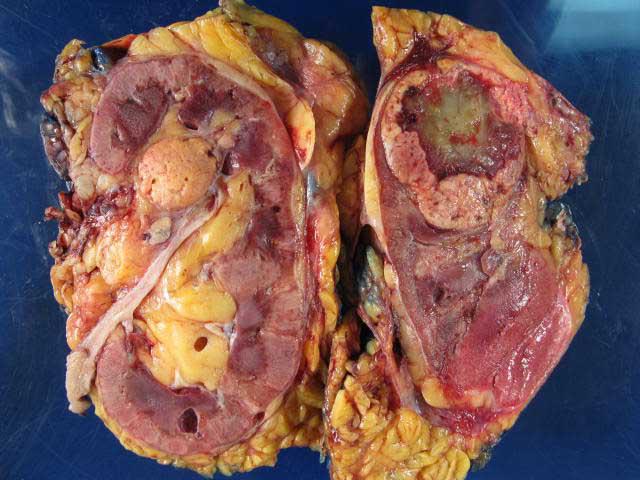
PALO ALTO, CA — In the past five years, 10 new system therapies have been approved for renal cell carcinoma (RCC), the most common type of kidney cancer. Despite the proliferation of treatments, overall survival rates have only incrementally improved. Five-year survival rates for metastatic renal cell carcinoma remains less than 20%.
Still, “the outlook for patients with metastatic renal cell carcinoma remains bright,” according to John Leppert, MD, MS, director of urologic oncology at the VA Palo Alto, CA, Health Care System and associate professor at the Stanford University School of Medicine. “While the overall survival has seen modest gains, there is reason to expect that these improvements will continue with the rapidly increasing number of treatments and options that are available for patients.”

In addition, advances in personalized medicine that help physicians match specific characteristics of a patient’s tumor to appropriate therapies may improve efficacy and minimize toxicity, Leppert told U.S. Medicine.
“Today, clinicians often will match patients with treatments using tried and true methods —clinicians will ask about each patient’s preference, inform them of possible side effects, and together they can decide on the best approaches. As the field of precision medicine advances, I expect that future discussions will include review of the genetic alterations of each patient’s tumor and perhaps even blood tests that will be able to monitor the response of each cancer to treatment in a way that will detect responses much quicker than can be seen on imaging tests like CT and MRI scans,” he said.
In an editorial in European Urology, Leppert elucidated some of the challenges to using blood tests and genetic alterations to guide therapy today. “Metastatic RCC, like all cancers, employs myriad strategies to grow, invade, metastasize and evade the host immune response. These actions are orchestrated via a unique genomic landscape, with several frequent mutations and a long right tail of rare variants,” he wrote.1
While next-generation sequencing has enabled the identification of mutations in circulating cell-free DNA (ctDNA), researchers do not yet know which genomic alterations drive RCC or which result from the cancer’s response to specific therapies.
A study of 220 patients with metastatic RCC analyzed genomic alterations in circulating tumor DNA following treatment with typical first-line therapies (sunitinib, pazopanib and bevacizumab) and those common in later lines (everolimus, axitinib, cabozantinib and nivolumab). Using an assay that included 73 common genomic alterations, they found genomic alterations in 78.6% of patients, with the most frequent across all treatments being TP53 in 35%, VL in 23%, EGFR in 17%, NF1 in 16% and ARID1A in 12%.2
Comparing alterations in those who received typical first-line regimens to those who received typical second line or later therapies detected notable changes in the frequency of TO53 (49% vs. 24), VHL (29% vs. 18%), NF1 (20% vs. 3%), EGFR (15% vs. 8%) and PIK3CA (17% vs. 8%). A subgroup analysis that looked at only patients treated with endothelial growth factor inhibitors in the first line found an even greater disparity in frequencies, with TP53 alterations twice as common in the first-line group (64% vs. 31%) and NF1 far more common (29% vs. 4%).
In his editorial, Leppert noted that the assay used did not include four of the nine most common mutations seen in RCC based on The Cancer Genome Atlas and the rate of TP53 alterations seen in the study was much higher than that found in previous tissue analyses. Issues like these explain some of the challenges in predicting response to new therapies, he told U.S. Medicine.
“There is no established list of which genetic changes or other important biomarkers should be included in testing,” he said. “So, as of today, we need more study of these possible markers to prove that they will actually help us select therapies to benefit patients.”
Leppert also noted that few patients in the study had serial ctDNA samples and “these showed decreasing agreement with increasing time between tests. This could illustrate a new challenge: temporal genetic heterogeneity.” That would add an additional level of complexity to the already known issues posed by spatial heterogeneity in tumors, which may require analysis of up to five biopsies of the same primary tumor or metastasis to capture 80% of the genetic mutations.
Future studies will need to evaluate the genetics and characteristics of each patient’s tumor, “but they will also include studies of the proteins that each tumor may make, and of the protein enzymes that may be the Achilles heel of each tumor,” Leppert said.
Greater understanding of the individual patient’s immune system and development of strategies that encourage the immune system to identify and attack the cancer will be part of future research and developments in treating RCC, he added.
“Taken together, I am optimistic about our increasing ability to treat veterans with metastatic kidney cancer and that we will continue to work toward improving the lives of patients diagnosed with renal cell carcinoma,” Leppert said.
11. Leppert JT. Applying precision oncology to renal cell carcinoma: emerging challenges. Eur Urol. 2017 Oct;72(4):565-566.
2Pal SK, Sonpavde G, Agarwal N, Vogelzang NJ, Srinivas S, Haas NB, Signoretti S, McGregor BA, Jones J, Lanman RB, Banks KC, Choueiri TK. Evolution of Circulating Tumor DNA Profile from First-line to Subsequent Therapy in Metastatic Renal Cell Carcinoma. Eur Urol. 2017 Oct;72(4):557-564.
